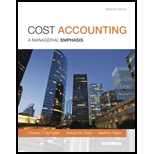
1.
Cost:
Cost refers to the expenses incurred by the business to earn revenue from sales, in other words cost is the amount given in order to get something.
Prime Costs:
Prime cost is a sum total of direct material costs and direct
Conversion Costs:
Conversion cost is sum total of direct manufacturing labor costs and manufacturing
To identify: The total prime costs and total conversion costs.
2.
Inventoriable Costs:
Inventoriable Costs is the cost of inventory hold by the business and are shown as an asset in the
Period Costs:
Period Costs is the cost incurred by the business except the cost of goods sold. Period costs are the expense of the same period in which it is incurred.
To identify: The total inventoriable costs and total period costs.
3.
To identify: The situation when design and R & D costs are regarded as product costs.
4.
To identify: The unit costs.
5.
To identify: The total costs.
6.
To identify: The
Want to see the full answer?
Check out a sample textbook solution
Chapter 2 Solutions
Cost Accounting (15th Edition)
- Saint Hill Inc. recorded a loss of $9,800 when it sold a van that originally cost $87,000 for $14,300. Accumulated depreciation on the van must have been__.arrow_forwardexplain properly all the answer for General accounting question Please given fastarrow_forwardEstimated MHs at the beginning of the period were?arrow_forward

 AccountingAccountingISBN:9781337272094Author:WARREN, Carl S., Reeve, James M., Duchac, Jonathan E.Publisher:Cengage Learning,
AccountingAccountingISBN:9781337272094Author:WARREN, Carl S., Reeve, James M., Duchac, Jonathan E.Publisher:Cengage Learning, Accounting Information SystemsAccountingISBN:9781337619202Author:Hall, James A.Publisher:Cengage Learning,
Accounting Information SystemsAccountingISBN:9781337619202Author:Hall, James A.Publisher:Cengage Learning, Horngren's Cost Accounting: A Managerial Emphasis...AccountingISBN:9780134475585Author:Srikant M. Datar, Madhav V. RajanPublisher:PEARSON
Horngren's Cost Accounting: A Managerial Emphasis...AccountingISBN:9780134475585Author:Srikant M. Datar, Madhav V. RajanPublisher:PEARSON Intermediate AccountingAccountingISBN:9781259722660Author:J. David Spiceland, Mark W. Nelson, Wayne M ThomasPublisher:McGraw-Hill Education
Intermediate AccountingAccountingISBN:9781259722660Author:J. David Spiceland, Mark W. Nelson, Wayne M ThomasPublisher:McGraw-Hill Education Financial and Managerial AccountingAccountingISBN:9781259726705Author:John J Wild, Ken W. Shaw, Barbara Chiappetta Fundamental Accounting PrinciplesPublisher:McGraw-Hill Education
Financial and Managerial AccountingAccountingISBN:9781259726705Author:John J Wild, Ken W. Shaw, Barbara Chiappetta Fundamental Accounting PrinciplesPublisher:McGraw-Hill Education





